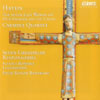Haydn The Seven Last Words of Our Saviour on the Cross
Sensitive string playing and choral singing in an unusual realisation of this reverential work
View record and artist detailsRecord and Artist Details
Composer or Director: Joseph Haydn, Anonymous
Genre:
Chamber
Label: Claves
Magazine Review Date: 7/2000
Media Format: CD or Download
Media Runtime: 74
Mastering:
DDD
Catalogue Number: 50-2002

Tracks:
| Composition | Artist Credit |
|---|---|
| Seven Last Words |
Joseph Haydn, Composer
Carmina Qt Joseph Haydn, Composer |
| (7) Gregorian Responsories for Holy Week |
Anonymous, Composer
(Father) Roman Bannwart, Conductor Anonymous, Composer Schola Romana Lucernensis |
Author: Stanley Sadie
Haydn’s Seven Last Words was designed for performance in Holy Week, in the Santa Cueva grotto in Cadiz, with discourses from the bishop on each of the seven utterances followed by Haydn’s musical meditation. These were the original orchestral pieces, not the string quartet versions (which Haydn made later, to widen access to the music) which are much more often given today. Haydn was concerned from the start that ‘seven Adagios’ would be exhausting to the listener, and I don’t imagine he would have favoured performance of them without a break (especially in the quartet setting, which is more intense in effect than the orchestral). The idea of interspersing them with Holy Week Gregorian responsories works reasonably well and is certainly an appropriate solution. The group singing them here is a mixed choir, although we hear either the men or the women, never the two together. They sing in a carefully moulded style, cadences softly rounded off; ensemble is precise, from the women especially.
The Carmina Quartet plays with a remarkably wide range of expression. The Introduction is quite fiercely done, and the ‘Terremoto’ at the end has a violence and is taken at a pace that almost obscures the pulse of the music. In between, they play the ‘seven Adagios’ (as Haydn called them – actually three Largos, two Graves, a Lento and an Adagio) as they would any other Haydn slow movement. The first is quite relaxed and lyrical, although its accents are well marked, and it has touches of added ornamentation. Refinement and delicacy of line characterise the second, and the third, the E major meditation on ‘Mother, behold thy son’, is done with much tenderness. In the fourth I found their realisation of Haydn’s notated ornaments – the appoggiaturas in bars 2 and 4, and at several points later – oddly perverse and disturbing: one played short, the other long, although the second phrase is a clear echo of the first (there is an analogy to this in No 2). No 5 (‘I thirst’) again draws some very telling soft playing from the quartet, but also pained forzato accents, and there is forceful expression of ‘Consummatum est’ in the next piece, along with moments of tenderness (for example, the G major modulation near the end). They play the E flat No 7 with the sense of calm and fulfilment that Haydn surely sought.
Their tempos, generally, seem to me well chosen, perhaps faster at times than many quartets take these pieces, but to my mind this helps bridge the gulf between Haydn’s normal mode of expression and the special significance of this remarkable music.'
The Carmina Quartet plays with a remarkably wide range of expression. The Introduction is quite fiercely done, and the ‘Terremoto’ at the end has a violence and is taken at a pace that almost obscures the pulse of the music. In between, they play the ‘seven Adagios’ (as Haydn called them – actually three Largos, two Graves, a Lento and an Adagio) as they would any other Haydn slow movement. The first is quite relaxed and lyrical, although its accents are well marked, and it has touches of added ornamentation. Refinement and delicacy of line characterise the second, and the third, the E major meditation on ‘Mother, behold thy son’, is done with much tenderness. In the fourth I found their realisation of Haydn’s notated ornaments – the appoggiaturas in bars 2 and 4, and at several points later – oddly perverse and disturbing: one played short, the other long, although the second phrase is a clear echo of the first (there is an analogy to this in No 2). No 5 (‘I thirst’) again draws some very telling soft playing from the quartet, but also pained forzato accents, and there is forceful expression of ‘Consummatum est’ in the next piece, along with moments of tenderness (for example, the G major modulation near the end). They play the E flat No 7 with the sense of calm and fulfilment that Haydn surely sought.
Their tempos, generally, seem to me well chosen, perhaps faster at times than many quartets take these pieces, but to my mind this helps bridge the gulf between Haydn’s normal mode of expression and the special significance of this remarkable music.'
Discover the world's largest classical music catalogue with Presto Music.

Gramophone Digital Club
- Digital Edition
- Digital Archive
- Reviews Database
- Full website access
From £8.75 / month
Subscribe
Gramophone Full Club
- Print Edition
- Digital Edition
- Digital Archive
- Reviews Database
- Full website access
From £11.00 / month
Subscribe
If you are a library, university or other organisation that would be interested in an institutional subscription to Gramophone please click here for further information.




